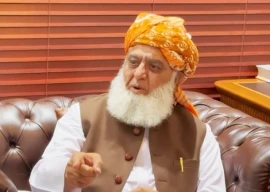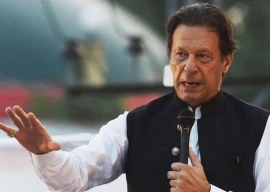
During a meeting of the National Economic Council (NEC) on Wednesday, the provinces also showed their scepticism about achieving the average 6.5% annual economic growth rate target that the outgoing government wants to set under the 12th Five Year Plan 2018-23.
Prime Minister Shahid Khaqan Abbasi chaired the meeting of the NEC – the highest constitutional body responsible for making macroeconomic policies. Except for the Punjab chief minister, all provincial governments’ heads attended the NEC meeting.
Voting for Sindh Assembly's PS-7 underway
The Planning Commission gave a presentation on the achievement of macroeconomic targets under the 11th Five Year Plan 2013-2018 and shared broader outlines of the 12th Five Year Plan.
“However, the presentation was silent on the issue of a weakening debt-bearing capacity of the country,” a government official who attended the meeting told The Express Tribune.
“Punjab Finance Minister Dr Ayesha Ghaus Pasha raised concerns over the debt situation and she was joined by Sindh Chief Minister Syed Murad Ali Shah,” said the official, adding that Shah asked about the federal government’s plan to tackle the monster of debt.
In June 2013, when the PML-N government came into power, the total public debt was Rs14.2 trillion or 63.9% of GDP. By June 2017, this has already increased to Rs21.4 trillion or 67.2% of GDP. Instead of tackling this problem, the former finance minister twice changed the definition of the public debt.
According to the officials privy to the meeting, PM’s Adviser on Finance Dr Miftah Ismail told the NEC members that a faulty resources distribution formula under the National Finance Commission (NFC) award was the reason behind the growing public debt.
Ismail told the NEC that out of the over Rs4 trillion tax collection that had been targeted, the provinces would take away Rs2.4 trillion, said the officials, adding that he informed the meeting that of the remaining Rs1.6 trillion, the cost of debt servicing was Rs1.4 trillion, leaving him with just Rs200 billon in hand to run the government.
Under the 7th NFC award, the provinces get 57.5% of the total federal divisible pool.
The prime minister stated that after the transfer of a majority of resources to the provinces, there was no incentive for the federal government to enhance revenue collection. It was agreed that the provinces and the Centre would sit together to resolve the issue at the NFC forum.
12th Five Year Plan
The NEC authorised the Planning Commission to prepare the draft of the 12th Five Year Plan, but the Punjab finance minister objected to the proposed 6.5% average annual economic growth rate target, said an official of the provincial government.
She was of the view that due to worsening problems related to current account deficit and budget deficit, at least two years were needed to stabilise the economy that would slow down the pace of economic growth, according to the official.
The IMF has also said that Pakistan’s twin deficits – current account and budget deficit – are worsening, projecting the highest-ever $16.6 billion current account deficit for this fiscal year.
The prime minister directed the Planning Commission that the main objective for the next five years should be to sustain the current high economic growth trajectory of 6%.
He also observed that keeping current account deficit and budget deficit within manageable limits, broadening the tax base, diversifying exports and containing the population growth were easier said than done.
The Planning Commission will present the draft plan in the next meeting of the NEC, which is expected to take place in May before the approval of the budget.
The Planning Commission told the NEC that as against the 3.7% average GDP growth rate achieved during the last PPP tenure, the average economic growth rate during the first four years of the PML-N government remained 4.4%.
However, the Sindh chief minister raised the objection, saying when the investment-to-GDP ratio fell in actual terms during the PML-N tenure, then how the economy could grow at 5% rate.
The Planning Commission chief economist could not give a satisfactory reply.
Regional disparities
The Sindh CM also questioned the Centre’s Punjab-focused development model and demanded a province-wise breakup of the public sector investment, according to the officials.
More than 92% of the spending under parliamentarians schemes was in Punjab, according to the Planning Commission documents.
However, Planning Minister Ahsan Iqbal said desegregating the national level projects on provincial lines was not possible.
The Sindh CM said that one of the main objectives of the NEC was to end regional disparities but the constitutional body was not able to achieve this objective. He said his province so far got less than 8% of the allocated budget during the current fiscal year.
Shah demanded that the current limit of Rs10 billion for the Provincial Development Working Party should be enhanced in order to facilitate fast approval of projects. The provincial schemes falling above Rs10 billion thresholds have to come before the CDWP for approval.
Resource generation: Provinces must concentrate on raising their own revenues
It was decided that all stakeholders would sit together to resolve the issue. The NEC approved enhancing the development budget sanctioning limits of Azad Jammu and Kashmir, Gilgit-Baltistan and FATA development committees to Rs1 billion.
The Planning Commission deputy chairman had proposed that the sanctioning limit of the Fata Development Committee should be enhanced from Rs400 million to Rs2 billion. But Planning Minister Iqbal opposed the proposal.
SDGs framework
The NEC also approved the National Framework and targets for the SDGs programme to prioritise the 17 SDGs as per Pakistan’s requirements.
Food security through sustainable agriculture, improved nutrition and healthy life, equitable quality education, improved drinking water and affordable clean energy have been declared immediate priorities of Pakistan.
Accelerating the rate of poverty reduction, empowerment of women and girls and building resilient infrastructure have been declared as category-II priorities requiring long-term policy interventions. Mitigating the impact of climate change and conversation of marine resources have been placed in the category-III.
1724760612-0/Untitled-design-(12)1724760612-0-405x300.webp)
















COMMENTS
Comments are moderated and generally will be posted if they are on-topic and not abusive.
For more information, please see our Comments FAQ